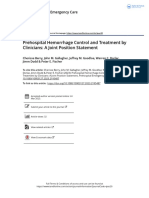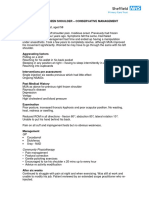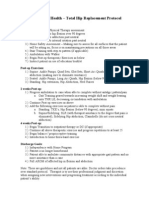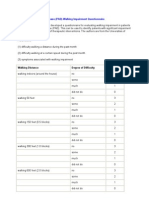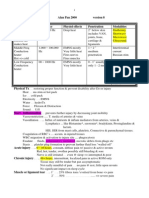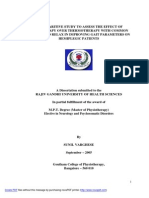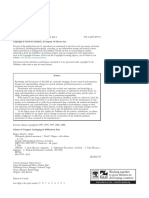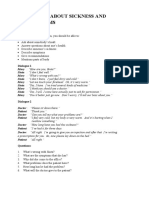0 ratings0% found this document useful (0 votes)
450 viewsRehab - Notes
Rehab - Notes
Uploaded by
chris blacRehabilitation aims to help people function at their highest level despite impairments. It is important for practitioners to understand as the elderly population grows. Rehabilitation addresses impairments, activities, and participation using two conceptual models: the ICF model which considers health conditions and environmental factors, and the ecological model which examines personal capacity and task demands. Effective rehabilitation often requires a multidisciplinary team to address complex needs, and can occur in inpatient, outpatient, or skilled nursing settings. Common interventions include exercise, cognitive training, occupational therapy, and assistive devices. Outcomes depend on the condition and how well the care setting matches individual needs.
Copyright:
© All Rights Reserved
Available Formats
Download as DOCX, PDF, TXT or read online from Scribd
Rehab - Notes
Rehab - Notes
Uploaded by
chris blac0 ratings0% found this document useful (0 votes)
450 views8 pagesRehabilitation aims to help people function at their highest level despite impairments. It is important for practitioners to understand as the elderly population grows. Rehabilitation addresses impairments, activities, and participation using two conceptual models: the ICF model which considers health conditions and environmental factors, and the ecological model which examines personal capacity and task demands. Effective rehabilitation often requires a multidisciplinary team to address complex needs, and can occur in inpatient, outpatient, or skilled nursing settings. Common interventions include exercise, cognitive training, occupational therapy, and assistive devices. Outcomes depend on the condition and how well the care setting matches individual needs.
Original Description:
geriatric rehab
Copyright
© © All Rights Reserved
Available Formats
DOCX, PDF, TXT or read online from Scribd
Share this document
Did you find this document useful?
Is this content inappropriate?
Rehabilitation aims to help people function at their highest level despite impairments. It is important for practitioners to understand as the elderly population grows. Rehabilitation addresses impairments, activities, and participation using two conceptual models: the ICF model which considers health conditions and environmental factors, and the ecological model which examines personal capacity and task demands. Effective rehabilitation often requires a multidisciplinary team to address complex needs, and can occur in inpatient, outpatient, or skilled nursing settings. Common interventions include exercise, cognitive training, occupational therapy, and assistive devices. Outcomes depend on the condition and how well the care setting matches individual needs.
Copyright:
© All Rights Reserved
Available Formats
Download as DOCX, PDF, TXT or read online from Scribd
Download as docx, pdf, or txt
0 ratings0% found this document useful (0 votes)
450 views8 pagesRehab - Notes
Rehab - Notes
Uploaded by
chris blacRehabilitation aims to help people function at their highest level despite impairments. It is important for practitioners to understand as the elderly population grows. Rehabilitation addresses impairments, activities, and participation using two conceptual models: the ICF model which considers health conditions and environmental factors, and the ecological model which examines personal capacity and task demands. Effective rehabilitation often requires a multidisciplinary team to address complex needs, and can occur in inpatient, outpatient, or skilled nursing settings. Common interventions include exercise, cognitive training, occupational therapy, and assistive devices. Outcomes depend on the condition and how well the care setting matches individual needs.
Copyright:
© All Rights Reserved
Available Formats
Download as DOCX, PDF, TXT or read online from Scribd
Download as docx, pdf, or txt
You are on page 1of 8
At a glance
Powered by AI
The key takeaways are that rehabilitation aims to allow people to function at the highest possible level despite impairments, and involves understanding disability through conceptual models and providing multidisciplinary care and interventions tailored to individual conditions.
The two conceptual models for disability discussed are the International Classification of Function, Disability, and Health (ICF) model from the WHO and the ecological model.
Benefits of coordinated multidisciplinary rehabilitation include systematically targeting multiple factors that contribute to disability through improving individual capacity, reducing task demands, or both. It has been shown to be effective for conditions like stroke, rheumatoid arthritis, falls, and frailty.
Rehabilitation and Rehab Sites Cristian Balcescu
Why do we need to know this? Because there is such a high incidence
of disabling conditions in the older adult population which can be
improved with rehab in many cases. The primary purpose of rehab is to
allow people to function at the highest possible level despite the
presence of physical impairment. The increasing numbers of this
elderly population will make it important for all practitioners to be
aware of the results possible with rehabilitation.
How do we start? TO understand disability and where/how rehab
services can be most effective we use on of two CONCEPTUAL MODELS
FOR DISABILITY
1. The International Classification of Function, Disability, and Health
(ICF), developed by the World Health Organization- individuals
level of function (body function, ability to execute a task
[activity], and participate in life activities) is determined by his or
her health condition(s) within the context of environmental and
personal factors. Medical and surgical interventions are directed
at the underlying health conditions causing disability;
rehabilitation services target the impairment, activities, and
participation levels of the disablement process, as well as
personal and environmental contextual factors that influence
activity and participation.
2. The ecological Model: Disability results from a mismatch between
individual capacity and task demands, which in turn are
influenced by the environment and the way in which tasks are
performed. For example, walking imposes different physical
demands when performed atop Mt. Everest versus at sea level.
Rehabilitation and Rehab Sites Cristian Balcescu
Thus, the ecological model helps to explain how personal and
particularly environmental contextual factors described in the
WHO ICF model interact with physical limitations to result in
disability. In the ecological model, remediation of disability
occurs through treatments that either increase individual
capacity or reduce task demand.
Rehabilitation interventions may improve capacity, reduce task
demands, or accomplish both
Impact of comorbidities on treatment
- comborbities can obviously delay treatment, require care plan to
be modified, but the complications can many times be
prevented.
- Skin breakdown monitor patients, and modify footware,
wheelchairs, bedding PRN
- Incontinence(and dangers of it), catheters and infections
- Pneumonia increased risk with inactivity, decreased swallowing
ability, underlying lung disease
- Anemia, mental functioning, DM(need for changes in medicine
and diet with increased exercise), heart disease(extreme
limitations in mobility, potential for orthostatic hypotension with
meds)
Who is involved?
- Treatment by a provider in a single discipline is often sufficient
for patients with uncomplicated conditions or with minimal
disability (eg, physical therapy for osteoarthritis of the knee or a
home safety evaluation by an occupational therapist for a patient
with fear of falling). However, for more complex or catastrophic
disability, a multidisciplinary team of providers is optimal to
address the rehabilitation needs related to progressive disability
and the interaction of multiple contributing conditions and
contextual factors.
- Multidisciplinary care is a cornerstone of rehabilitation. The
efficacy of coordinated multidisciplinary rehabilitation for a
number of conditions affecting older adults, including stroke,
rheumatoid arthritis, falls, and frailty, is supported by numerous
Rehabilitation and Rehab Sites Cristian Balcescu
studies. Geriatric evaluation and treatment units provide
multidisciplinary care with medical, social service, nursing, and
rehabilitation personnel (typically physical and occupational
therapy) working together in a coordinated fashion. Inpatient
stroke rehabilitation teams include a variety of rehabilitation
personnel (eg, speech therapy, occupational therapy, physical
therapy) to target rehabilitation therapies to the specific strokerelated deficits, as well as medical, nursing, and other staff.
Coordination of care may be achieved with weekly team
meetings and/or scripted protocols to facilitate care coordination.
Benefits from coordinated multidisciplinary rehabilitation accrue
from systematically targeting the multiple factors that interact to
cause and exacerbate disability. For example, stroke may
adversely affect visual perception, speech, and cognition as well
as cause paralysis. Members of the multidisciplinary team often
have both unique and overlapping expertise, reinforcing the
interventions of each other.
Rehabilitation and Rehab Sites Cristian Balcescu
Where can patients be treated?
- effect of sites of care on rehab outcomes is not well established.
However, each has advantages and disadvantage
- Inpatient is most intense, but may not be endurable for frail older
patients as it requires 3hrs daily activity. SNFs are good for those
needing round the clock care without a round the clock caregiver
at home. Outpatient allows pts to return home, but the support
system may not be as strong and this requires transportation
which can be costly and time consuming.
Rehabilitation and Rehab Sites Cristian Balcescu
-
We should try to match individual patients to the care they need,
but sometimes decision is driven by cost
What can we do? Interventions
Each condition has different approaches that have been studied to
varying degress and work better for particular conditions(stroke,
postTHA, post TKA, etc)
Exercise
Rehabilitation and Rehab Sites Cristian Balcescu
-
Exercise, a type of physical activity, is defined as a planned,
structured, and repetitive bodily movement done to improve or
maintain one or more components of physical fitness (eg, muscle
strength, flexibility, balance)
Certain types of exercise may be particularly beneficial for
specific patient populations. As an example, resistive exercise
and power training have been found to improve function in frail
older adults [21]. A systematic review found that progressive
resistance exercise (ie, weightlifting) can significantly improve
muscle strength and, to a lesser extent, functional activities such
as rising from a chair and ambulation [22].
During acute hospitalization, early mobilization seems to offer
particular benefit, improving outcomes in multiple patient
populations, including patients with hip fracture, acute
pneumonia, or critical illness in the intensive care unit [23-25]
Cognitive rehab- may improve alertness and attention.
Language therapy post CVA aphasia
OT- repetition of tastk specific activities such as bed transfers,
grasping, reaching, retraining in IADLs
Research has not shown that speech, languance cognitive rehab
improve functional deficits.
Assistive devices:
Rehabilitation and Rehab Sites Cristian Balcescu
Example:
Post THA
- 5% mosrtality during initial hospitalization, 25% at 1 year, up to
half will continue to need assistive devices, 25% will need lng
term care 1 year later, 1.2 need some transient long term care
- early repair within 24-72 hours has been shown to reduce 1 year
mortality and complications of pressure ulcers, delirium.
Rehabilitation and Rehab Sites Cristian Balcescu
-
Rehab focuses on pain management, mobilizations, prevention of
complications(PE, delirium). Most important factors are early
mobilization, and frequency of therapy(>once daily better
outcomes than once a day or less)
Anticoagulation min 10d up to 30+ day course. ASA, LMW
heparin at a usual high-risk dose, fondaparinux, a vitamin K
antagonist (target INR 2.5, range: 2.0 to 3.0), or rivaroxaban.
Prevention of future fractures osteoporosis, home safety risks,
balance training
You might also like
- Amyotrophic Lateral SclerosisDocument24 pagesAmyotrophic Lateral SclerosisJeanessa Delantar QuilisadioNo ratings yet
- Books Media-: Clinical Assessment Procedures in Physical TherapyDocument1 pageBooks Media-: Clinical Assessment Procedures in Physical Therapybrain jackNo ratings yet
- 3.bpt 1213 PDFDocument110 pages3.bpt 1213 PDFSafeer MNo ratings yet
- Montana Board of Physical TherapyDocument12 pagesMontana Board of Physical TherapyebookNo ratings yet
- 1 - Introdution To OrthopedicsDocument13 pages1 - Introdution To OrthopedicsMuhammad BilalNo ratings yet
- It Fractures Management Dhs Vs PFN: Sayeeda QudsiaDocument26 pagesIt Fractures Management Dhs Vs PFN: Sayeeda QudsiasayeedaNo ratings yet
- RS2480 Amputation 2018Document49 pagesRS2480 Amputation 2018Hung Sarah100% (1)
- Complete Neurologic Interventions For Physical Therapy Third Edition Kessler PDF For All ChaptersDocument52 pagesComplete Neurologic Interventions For Physical Therapy Third Edition Kessler PDF For All Chapterstateiouazib100% (4)
- Glassgow Coma Scale and Rancho Los AmigosDocument17 pagesGlassgow Coma Scale and Rancho Los AmigosHEMA CHANDRANNo ratings yet
- ASIA Impairment ScaleDocument10 pagesASIA Impairment Scaleazimahzainal211No ratings yet
- Septic Arthritis UpgradedDocument47 pagesSeptic Arthritis UpgradedVishva Randhara AllesNo ratings yet
- New Techniques in Physical TherapyDocument61 pagesNew Techniques in Physical TherapyMohamed Magdy El MeligieNo ratings yet
- Health and Wellness: DR Kainat Faizan BSPT (G Old-Medalist), PPDPTDocument32 pagesHealth and Wellness: DR Kainat Faizan BSPT (G Old-Medalist), PPDPTAflaha KhanNo ratings yet
- Evidence-Informed Primary Care Management of Low Back Pain - Clinical Practice Guideline - CanadaDocument49 pagesEvidence-Informed Primary Care Management of Low Back Pain - Clinical Practice Guideline - CanadaCambriaChicoNo ratings yet
- Descriptive Study DesignsDocument53 pagesDescriptive Study DesignsErmiasNo ratings yet
- StrokeDocument16 pagesStrokeFahmi AbdullaNo ratings yet
- The Timed Up & Go - A Test of Basic Functional Mobility For Frail Elderly Persons. lAGSDocument7 pagesThe Timed Up & Go - A Test of Basic Functional Mobility For Frail Elderly Persons. lAGSJose Fernando Díez ConchaNo ratings yet
- Final Exame of Physical TherapyDocument6 pagesFinal Exame of Physical TherapydrDaoudNo ratings yet
- Balance Error Scoring System (BESS) PDFDocument7 pagesBalance Error Scoring System (BESS) PDFCleber PimentaNo ratings yet
- Fluidotherap by DR VVR ChowdharyDocument3 pagesFluidotherap by DR VVR Chowdharyvenkata ramakrishnaiahNo ratings yet
- Tarsal Tunnel Syndrome - Physiopedia, Universal Access To Physiotherapy KnowledgeDocument9 pagesTarsal Tunnel Syndrome - Physiopedia, Universal Access To Physiotherapy KnowledgeMuhammad Sahrul PatunruNo ratings yet
- Periarthritis Shoulder By: DR - Sindhu.MPT (Ortho)Document39 pagesPeriarthritis Shoulder By: DR - Sindhu.MPT (Ortho)Michael Selvaraj100% (1)
- Bells PalsyDocument18 pagesBells PalsyDr AnandNo ratings yet
- Epidemiology of Coronary Heart DiseasesDocument31 pagesEpidemiology of Coronary Heart DiseasesShaimaa EmadNo ratings yet
- Open MPT 2020-21 Syllabus NewDocument90 pagesOpen MPT 2020-21 Syllabus NewsmrutiptNo ratings yet
- Guillain-Barré SyndromeDocument60 pagesGuillain-Barré SyndromekharaNo ratings yet
- Prehospital Hemorrhage Control and Treatment by Clinicians A Joint Position StatementDocument15 pagesPrehospital Hemorrhage Control and Treatment by Clinicians A Joint Position StatementPaulMoreanoNo ratings yet
- Introduction To Clinical Decision MakingDocument40 pagesIntroduction To Clinical Decision MakingVANSHIKANo ratings yet
- Case Study 2Document16 pagesCase Study 2sumit100% (1)
- Sergiu Modified Gait Abnormality Rating Scale PDFDocument2 pagesSergiu Modified Gait Abnormality Rating Scale PDFmitroisergiuNo ratings yet
- Beard's Massage_ Principles and Practice of Soft TissueDocument340 pagesBeard's Massage_ Principles and Practice of Soft Tissuecdcddcdc5566No ratings yet
- PT in Geriatric ConditionsDocument12 pagesPT in Geriatric ConditionsJiggs LimNo ratings yet
- Advanced Physiotherapeutic SyllabusDocument1 pageAdvanced Physiotherapeutic SyllabusAnup SharmaNo ratings yet
- Case History Frozen ShoulderDocument2 pagesCase History Frozen ShoulderSaliha Akram0% (1)
- Lumbar Radicular Pain: PathophysiologyDocument4 pagesLumbar Radicular Pain: PathophysiologynetifarhatiiNo ratings yet
- Chapter # 4: Physical Assessment As A Screening ToolDocument89 pagesChapter # 4: Physical Assessment As A Screening Toolmuhammad awaisNo ratings yet
- Chris Littlewood - Stephen May - Understanding Physiotherapy Research-Cambridge Scholars Publishing (2013)Document136 pagesChris Littlewood - Stephen May - Understanding Physiotherapy Research-Cambridge Scholars Publishing (2013)Aya KhalilNo ratings yet
- Application of Wellness in Physical TherapyDocument26 pagesApplication of Wellness in Physical TherapyZgama AbdulrahmanNo ratings yet
- Sci Asia Scale PPT (Final)Document29 pagesSci Asia Scale PPT (Final)palNo ratings yet
- History Taking Form Final - Doc Version 1Document5 pagesHistory Taking Form Final - Doc Version 1Mahnoor AqeelNo ratings yet
- Pre and Post Operative Physiotherapy Management in Tendon Transfer of HandDocument59 pagesPre and Post Operative Physiotherapy Management in Tendon Transfer of HandjothiNo ratings yet
- Physical Examination of The Critically Injured AthleteDocument19 pagesPhysical Examination of The Critically Injured AthleteAyesha LatifNo ratings yet
- Total Hip Replacement - ProtocolDocument1 pageTotal Hip Replacement - ProtocolAhmad Rifai SarrajNo ratings yet
- Peripheral Arterial Disease (PAD) Walking Impairment QuestionnaireDocument4 pagesPeripheral Arterial Disease (PAD) Walking Impairment QuestionnaireIoana Margineanu0% (1)
- PhysiotherapyDocument53 pagesPhysiotherapybjpalmer100% (2)
- Cryotherapy and Steching in HemiplegiaDocument70 pagesCryotherapy and Steching in HemiplegiaAkheel Ahammed0% (1)
- Lec 3 Definition of PhysioDocument18 pagesLec 3 Definition of PhysioBhargav100% (1)
- Chap 4. Manual Therapy For Thoracal SpineDocument31 pagesChap 4. Manual Therapy For Thoracal SpineMita SuryatniNo ratings yet
- Spine Trauma and Spinal Cord InjuryDocument32 pagesSpine Trauma and Spinal Cord InjurytoroideaNo ratings yet
- Laboratory Manual Guidelines For Exercise Rehabilitation 1 EditionDocument61 pagesLaboratory Manual Guidelines For Exercise Rehabilitation 1 EditionMalabaris Malaya Umar Siddiq100% (1)
- Volkmann's Ischemic Contracture by Innocent C. AbuguDocument38 pagesVolkmann's Ischemic Contracture by Innocent C. AbuguChukwuemeka ChidogoNo ratings yet
- Cardiovascular Regulation and Integration: Mcardle, Katch, and Katch: Exercise Physiology: EnergyDocument24 pagesCardiovascular Regulation and Integration: Mcardle, Katch, and Katch: Exercise Physiology: EnergyamrendraNo ratings yet
- COMMUNITYDocument45 pagesCOMMUNITYAkshay BadoreNo ratings yet
- Ankle Examination Orthopaedics McraeDocument6 pagesAnkle Examination Orthopaedics McraeHafizah HoshniNo ratings yet
- MPT Question BankDocument26 pagesMPT Question BankAbilash Prabhuraj M KNo ratings yet
- Dr. M. FaheemDocument28 pagesDr. M. FaheemSuganya Balachandran0% (1)
- Magee 6th Edition - OPA - Copyright PageDocument1 pageMagee 6th Edition - OPA - Copyright PageRonny Araya AbarcaNo ratings yet
- Minimally Invasive Surgery for Chronic Pain Management: An Evidence-Based ApproachFrom EverandMinimally Invasive Surgery for Chronic Pain Management: An Evidence-Based ApproachGiorgio PietramaggioriNo ratings yet
- LC Yuliati-19340019Document5 pagesLC Yuliati-19340019Tiara PutriNo ratings yet
- Lab 7 Genus NeisseriaDocument20 pagesLab 7 Genus NeisseriaAAANo ratings yet
- Thyroid Symptom HackerDocument19 pagesThyroid Symptom HackerMuhammad Faisal kamranNo ratings yet
- Chapter 42Document10 pagesChapter 42Faith Mamaril (Faithy)No ratings yet
- Dapoxetine Hydrochloride Prescribing InformationDocument17 pagesDapoxetine Hydrochloride Prescribing InformationAdnan TowfiqueNo ratings yet
- Breathwork in Body Psychotherapy Towards A More Unified Theory and PracticeDocument14 pagesBreathwork in Body Psychotherapy Towards A More Unified Theory and PracticeSiyao LiNo ratings yet
- PM - NaceDocument3 pagesPM - Nacemohammad tahirNo ratings yet
- CIMTDocument21 pagesCIMTAndi Noviqa WulandariNo ratings yet
- The Microbial World & You: NomenclatureDocument9 pagesThe Microbial World & You: NomenclatureApryll DarlineNo ratings yet
- Latest List of Hospitals - 1Document15 pagesLatest List of Hospitals - 1ShashikumarNo ratings yet
- Kofarest PD SyrupDocument3 pagesKofarest PD SyrupAshokrajNo ratings yet
- 14 Talking About Sickness and SymptomsDocument9 pages14 Talking About Sickness and SymptomsAdin SukamtoNo ratings yet
- Deleting MemoriesDocument13 pagesDeleting Memoriessimon jordan1005No ratings yet
- Subject: Midwifery and Obstetrical Nursing Course Plan (Session 2020-2021) PlacementDocument12 pagesSubject: Midwifery and Obstetrical Nursing Course Plan (Session 2020-2021) PlacementAashmeen KaurNo ratings yet
- Interventions For The Management of Acute and Chronic Low Back Pain: Revision 2021Document61 pagesInterventions For The Management of Acute and Chronic Low Back Pain: Revision 2021Beca MolinaNo ratings yet
- Third MolarDocument19 pagesThird MolarMike LimNo ratings yet
- Textbook of Diabetes and Pregnancy - CRC Press 4th 2025Document460 pagesTextbook of Diabetes and Pregnancy - CRC Press 4th 2025hocycungtui2323No ratings yet
- KK 090123 Gran TorinoDocument1 pageKK 090123 Gran TorinokatehasablogNo ratings yet
- Effectiveness of Homoeopathic Therapeutics in The Management of Childhood Autism DisorderDocument13 pagesEffectiveness of Homoeopathic Therapeutics in The Management of Childhood Autism DisorderShubhanshi BhasinNo ratings yet
- Aerb/Rsd/ Mdx-Ct-Cath /sla & Proc)Document4 pagesAerb/Rsd/ Mdx-Ct-Cath /sla & Proc)noore rabbaniNo ratings yet
- Retdem NeuroDocument3 pagesRetdem NeuroCharlize PareNo ratings yet
- Casos Clinicos Ingles Enarm 2019Document24 pagesCasos Clinicos Ingles Enarm 2019AlbertoLeónBojórquezNo ratings yet
- Post Guidelines - June 16Document52 pagesPost Guidelines - June 16kevin clone1No ratings yet
- The Delirium Rating Scale (DRS)Document12 pagesThe Delirium Rating Scale (DRS)Cristian SolísNo ratings yet
- Lifestyle-Medicine Boost-Immunity FlyerDocument2 pagesLifestyle-Medicine Boost-Immunity FlyerArie Angga100% (1)
- Impulsivity Causes Control and Disorders 1nbsped 9781617285202 9781607419518 CompressDocument268 pagesImpulsivity Causes Control and Disorders 1nbsped 9781617285202 9781607419518 CompressNajya AzzahraNo ratings yet
- Suicide Prevention PowerPoint - For TeachersDocument55 pagesSuicide Prevention PowerPoint - For TeachersJeremy Horton100% (1)
- Old Age and Aging: October 2019Document11 pagesOld Age and Aging: October 2019Anup AdhikariNo ratings yet
- FDA Approves First Gene Therapy, Betibeglogene Autotemcel (Zynteglo), For Beta-ThalassemiaDocument3 pagesFDA Approves First Gene Therapy, Betibeglogene Autotemcel (Zynteglo), For Beta-ThalassemiaGiorgi PopiashviliNo ratings yet
- You're Never A Loser 'Til You Quit Trying. Anonymous: Risk For InjuryDocument8 pagesYou're Never A Loser 'Til You Quit Trying. Anonymous: Risk For InjuryMichael Baylon DueñasNo ratings yet



























